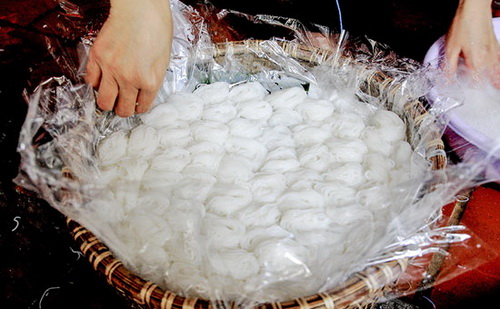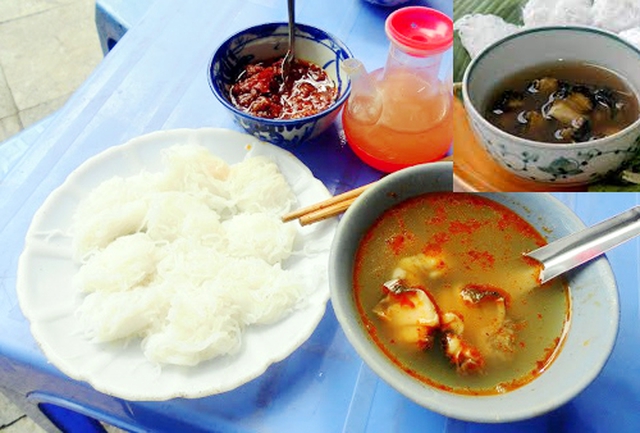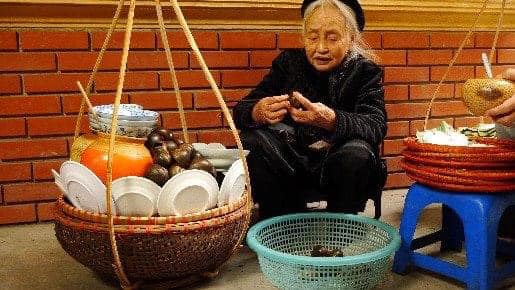What’s strange about those who carry the burden and squeeze Tu Ky vermicelli to revive a specialty that only the capital can have?
What’s strange about Bun Tu Ky?
In Hanoi, there are Mai Trang vermicelli (Dong Anh, Hanoi), Phu Do vermicelli (Tu Liem, Hanoi) occupying market share in the west of the inner city, Tu Ky vermicelli (Thanh Tri, Hanoi) is sold and bought. widely in the south of Hanoi, from Village Tam, Giap Bat to Ngoc Hoi, Ngu Hiep and inner city markets such as Hom market, Mo market…
There is a saying in Hanoi’s old folk song:
Delicious noodles with cool noodles from Tu Ky
Phap Van is not an exaggeration

Squeeze noodles in the shape of a Tu Ky spiral. Illustration.
On the side of the north-south natural path, two villages Phap Van and Tu Ky belong to the ancient land of Thanh Tri district. The land of Phap Van field is deep and low, with many crabs and snails. Phap Van women and girls have the profession of selling cold snail vermicelli. Quang burden is often burdened on one side – because the jar of cold snail water and boiled snails are usually heavier than the basket of cool noodles on the other side.
This unique profession has been around for nearly half a century and has gradually disappeared. Fortunately, in the 21st century, there are signs of reappearance, but it is still not as popular as hot snail noodles.
The villagers of Tu Ky are faithful to the noodle making profession associated with an ancient legend – that is, in the Later Le Dynasty about 400 years ago, there were 3 boys from a strange land who followed the natural path to earn a living in Tu Ky land.
One person is good at making vermicelli, one is good at shaping pots and pans, and one is specialized in knitting baskets – so the villages of farming and making vermicelli exist in parallel.
The old Tu Ky village specialized in growing delicious rice varieties for vermicelli, such as Pot rice and Hien rice.
Another person weaves baskets to wash rice and store noodles.
Another person specializes in kneading earthenware pots and jars as tools for soaking rice and boiling vermicelli (aluminum and bronze are rare, only earthenware pots and pans are available).
How to make vermicelli of Tu Ky people
The rice used to make Tu Ky vermicelli must be delicious, not fussy, it’s freshly harvested rice from the countryside (because a lot of vermicelli fibers will stick and it will waste rice). Rice for the season is both easy to make and redundant.
After the rice is milled, it must be gradually sieved to remove all the husks and grit, then soak in clean water. In the summer, soak the old age for half an hour. In winter, it is soaked for 1 day – about 8 hours, whether day or night.

The profession of selling delicious cold snail vermicelli without fishy taste belongs to the people of Phap Van village, while squeezing snail shaped vermicelli is done by Tu Ky people. Illustration.
After soaking the rice, wash it with cold water, then put it in the mill to make a fine powder. Nowadays, there is a grinder so it is fast, but in the past, using a hand grinder took a lot of time. When the flour is finished grinding, it must be soaked for a few days (if it is hot), or soaked for 3 days (if it is cool). In the cold winter, sometimes you have to soak rice for up to 4 days.
Soak rice flour just enough to put it in a duffel bag and squeeze out the water, like squeezing the flour of the vegetarian cake. The more the dough is drained, the firmer and more flexible the noodles are. If you want to be thorough, you have to knead the dough again until smooth.
The dough cake is put on a dedicated wooden rack, for sure. Wait for the large pot of water on the stove to boil, the worker will drop both the flour cake and the wooden rack to boil.
A good vermicelli maker is adept at assessing the maturity of the vermicelli dough. That is, when you put the dough cake in the pot, it’s boiled about 1/10 – that is, the color of the dough is a little bit clear. If you misjudge the time of boiling the dough, it will affect the firmness of the noodles.
Accordingly, the flour cake is picked up at the right time and will be put into the mortar and pounded like rice – so when there was no machine at night, Tu Ky village was bustling with the beat of the pestle pounding vermicelli like a idyllic and soulful night music in the beloved countryside.
Now it’s all millwork, much less burdensome for the people, but the old people in the village feed the forest with ground flour vermicelli, which is not as delicious as pounded flour vermicelli. That’s because the batter is more viscous and finer, making the noodles firmer and more supple.
Squeezing the vermicelli is the last step before the finished product.
People built a pot with a wide mouth to boil water. The person sitting in the kitchen took the chopstick and quickly stirred the water to make a circle like a spiral.
Another worker took a few pounds of vermicelli powder and put it in a large coarse cloth towel, in the middle of the towel there was a circular hole sewn into the mouth of an iron mold with many small holes, squeezed the dough to make it flow into a pot of boiling water.
Fine white flour fibers flow down the entire batch without breaking or tangling. This stitch used to need a strong, resilient man. Now this process of squeezing vermicelli is fully mechanized, so making vermicelli is much less difficult.

The cold snail vermicelli hawker stalls use Tu Ky vermicelli noodles. Illustration.
When the pot of water boils again, the cooked vermicelli will emerge, the worker picks up the vermicelli with a racket and quickly pours cold water for the noodles to hunt again. Then drop the vermicelli into a basin of cold water to further soak to prevent sticking and add firmness to the noodles.
The assistant worker, usually a woman with small, skillful hands, is very suitable for squeezing vermicelli on the cleaned green banana leaves according to the predetermined design.
Tu Ky vermicelli has many varieties, squeezed in different designs to suit traditional dishes.
– The style of vermicelli is stretched to the end of the basket – to eat shrimp and meat rolls with blanched onions, and coriander, laksa leaves. This bun style is not popular, if you want to eat, you must order in advance.
– Round vermicelli (like Quan Ganh thick cake) to eat vermicelli, vermicelli, fried bean vermicelli with shrimp and lemon sauce.
– The type of vermicelli used to eat hot soups such as vermicelli, vermicelli, vermicelli…
– Particularly, the style of vermicelli is squeezed in the shape of a small and beautiful snail like a coin, exclusively for Phap Van cold snail noodle shops.
There are shops and restaurants that want to make their own impression of this type of vermicelli, but the price is more expensive because it takes more workers. The white vermicelli noodles are lined up on the green, smooth banana leaves, evoking a feeling of purity and coolness.
Up to now, in some big markets in the city, there are still women and sisters from Tu Ky with scarves and brown blouses, sitting and chewing betel nut next to baskets of pure white vermicelli peeking out from under the fresh green banana leaves. fresh upside down.
at Blogtuan.info – Source: cafebiz.vn – Read the original article here



